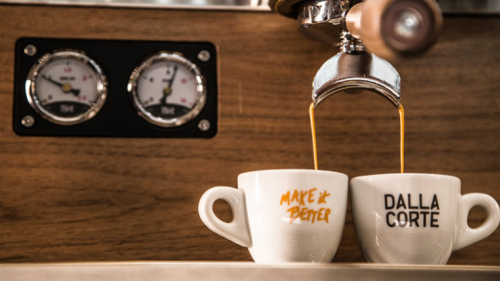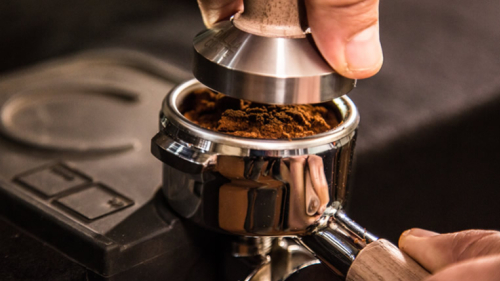Conical vs Flat Burr Grinders
May 13, 2020
Do you know the differences between conical and flat burrs?
In Perfect Daily Grind's article, we discuss this important topic!
Discover the article at https://perfectdailygrind.com/2020/05/conical-vs-flat-burr-coffee-grinders-whats-the-difference/
Source:
Perfect Daily Grind
Your
grinder is one of the most important pieces of coffee equipment you’ll own,
whether you’re a café owner or a home brewer. A poor-quality machine will
result in an uneven grind size, which in turn will cause inconsistent
extraction rates and a muddy cup.
Using a
burr grinder will significantly improve your coffee’s quality. Since burrs
grind with pressure rather than through chopping the beans, they result in
fewer tiny fragments, or fines, than a blade grinder. Yet there are two
different types of burrs you can choose from: flat and conical.
What’s the
difference between these burrs? How do they affect the precision and
consistency of your grind size, as well as the risk of coffee retention? Should
you buy a conical or flat burr grinder? Read on to find out.
WHAT ARE
CONICAL & FLAT BURRS?
With a burr
grinder, coffee is ground through pressure as it passes between two surfaces or
burrs.
Flat burrs
are made up of two rings that lie flat on each other. They are often
horizontally aligned and have angled teeth. It is the distance between the
rings that determines the size.
With
conical burrs, however, the grinding happens vertically. One burr sits inside
another. The outer burr is a circular, hollow ring with angled teeth. Picture a
cupcake wrapper without the base, and you’re pretty much there. The inside burr
is conical with a larger base. If you look at it from above, it can appear
star- or flower-shaped. This is because it has channels that help the beans to
funnel through. It also has small angled teeth.
HOW DOES
BURR SHAPE AFFECT YOUR COFFEE QUALITY?
Grind
consistency, retention, and temperature – all of these can affect the quality
of your espresso shots and filter coffees. And all of these are to some degree
affected by the burr shape.
Grind
Consistency
Marco
Beltrame, Coffee Trainer and Technician at Dalla Corte, tells me that it’s
difficult to achieve the same level of grind consistency with conical burrs as
with flat burrs. This is due to how they’re assembled.
“The
biggest difference between conical and flat burrs is during the assembly and
construction of the coffee grinder,” he says. “In conical burrs, it is necessary
to achieve perfect parallelism and perfect concentricity, while with flat
burrs, only parallelism is important. Therefore, it is easier to obtain better
homogeneity of the particle size.”
In fact, he
believes that flat burrs will always outperform conical burrs. “The more the
parallelism is perfect, the higher the granulometry precision will be. In
conical burrs, it is impossible to have perfect concentricity, given that the
lower burr will have to be mounted on the motor shaft and therefore it will
certainly remain decentralized from it.”
In other
words, the difficulty in creating an exact alignment with conical burrs can
lead to small inconsistencies in the grind size.
However,
there is one thing that can cause issues with a flat burr grinder’s
consistency: heat retention. Flat burr grinders have a reputation for heating
up more throughout the day than conical burr ones. This is because flat burrs
require more mechanical power.
Marco
stresses that this depends on how the grinder has been manufactured. “A coffee grinder with flat burrs can get
very close to the conical temperatures if it’s built with the necessary
technical precautions, such as proper ventilation and speed of grinding,” he
says.
He uses the
Dalla Corte burrs as an example, telling me that “the 65 mm burr diameter and
the 1400 RPM of the motor are important for obtaining a not-high peripheral
speed and lower heat.”
However,
the extra heat could cause issues for cheaper grinders.
Cole Torode
of Rosso Coffee Roasters, several-time Canadian Barista Champion and a Dalla
Corte Coffee Ambassador, tells me, “If a grinder heats too much, it’s going to
change the consistency of the grind size…
“As your
day progresses at the café and the ambient temperature in the room is starting
to go up, you’ll feel that your grinder temperature is more than likely also
starting to go up and I would assume that your shots are going to start
extracting faster as the grinds are heating up, because they become slightly
more soluble.”
This means
that baristas working with flat burr grinders will have to pay careful
attention to the temperature. If it rises too much, they’ll need to adjust the
grind size for their espresso shots.
Coffee
Retention & Contamination
Coffee
retention, where grinds are left behind in the machine, can result in varying
dry-coffee weight, altering your espresso extraction. Perhaps even more
worryingly, it can cause contamination, with stale grounds mixed in with fresh
ones.
Retention
happens when ground coffee sticks to surfaces within the grinder. This is more
likely to happen with flat burrs than conical ones because of how the coffee
feeds out of the machine.
With flat
burrs, the coffee is pushed sideways out of the burr set. This takes a lot of
force, and to achieve this, the grinder’s engine rotates at a higher RPM.
Conical setups, in contrast, require less mechanical force as gravity is
helping the grains to feed through. This means the risk of retention is lower.
However,
Marco stresses that retention can be reduced in flat-burr grinders, based “on
how the grinding chamber and its outlet mouth are built”.
EASE &
CONVENIENCE OF USE
Ease of use
often has more to do with the grinder design than the burrs, but there are a
few differences between conical and flat sets.
The noise
is probably the first thing you’ll notice: conical burr grinders run at a lower
RPM because gravity is doing a lot of the work for them. As a result, they are
usually quieter.
However,
like most things, grinder manufacturers can take additional steps to reduce
noise. “To reduce the grinding noise [in Dalla Corte machines], one burr has
six more grinding teeth than the other,” Marco tells me.
And as
we’ve said above, flat burr grinders can also require more adjustments
throughout the day as the temperature rises, unless they have a good
ventilation system. Again, this is due to the higher RPM.
IT’S NOT
JUST ABOUT BURR SHAPE
Burr shape
has an impact on the quality of your coffee, but it’s not the only thing you
should look for.
Marco says,
“Regardless of flat or conical grinders, the workflow is determined by how the
entire grinder is made, the diameter and design of the grinders, the motor and
its speed, the ventilation, and the whole machine body.”
Pay
attention to whether the grinder burrs have been designed specifically for
espresso or for a variety of beverages. Marco tells me that Dalla Corte’s burrs
are “around 300/450 microns” to make them suitable for espresso, while some
grinders are designed to be more flexible instead.
Some people
also have a preference for ceramic or metal-alloy burrs. Ceramic is harder than
steel, which means the burrs will stay sharp for longer. Yet it’s also more
brittle. Small stones and other objects can end up cracking them. Ceramic also
absorbs less heat – however, most of the heat generated in grinding is due to
the RPM and the crushing of the beans. In reality, there is little difference
between ceramic and metal burrs. Most manufacturers opt for metal ones.
CONICAL VS
FLAT BURRS: WHICH IS BEST?
The answer
is: it depends.
Generally
speaking, flat burrs are more consistent and more expensive. Depending on the
model, they can also be noisy and, unless there is good ventilation, heat up
quickly.
In
contrast, most conical burrs are quieter, cooler, and cheaper, but less consistent.
You need to
work out which aspects are important to you. Are you operating a specialty
coffee shop where precision is key? Or are you an early riser looking for a
basic home grinder that won’t wake up the rest of the family?
Remember
that burrs are important, but they’re not the only thing that determines
grinder quality. Is the machine well-built? Is it appropriate for the drinks
you want to make? Is good support available if you need it repaired or
replaced?
Once you have the answers to these questions, you’ll be able to make the right purchasing choice.

Latest news
THIRD WAVE COFFEE: THE NEW ERA OF QUALITY COFFEE
Feb 18, 2025









